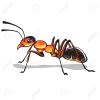Watch a Tetramorium sp. colony eat prey in an outworld with 1/2" of loose sand and you'll change the way you think! I can't wait to try this with other species.
They will dig a pit as deep as possible underneath the prey, until the sides are slippery, then tear it apart in little pieces. The sides are too steep for multiple ants to pull the prey out.
There are multiple advantages in the wild from this behavior, let's explore a few:
- prevents injured prey from escaping
- helps to hide the prey from other predators, both from sight and smell
- prevents large pieces from being dragged to and inside the nest. This might cause mold/contamination inside the nest. Also, if the pieces are too large to fit in the nest entrance, this could prolong the time that predators may be attracted to the nest location.
It's a cool thing to see a steady line of ants going back to the nest from the pit. I imagine they are taking their little morsels to the brood pile to feed the larvae and queen.
I'm watching 30 or so right now in an active pit zone tearing apart a spider. The entire feeding time you see a number of ants grabbing sand from the bottom and transporting away from the pit. Some will bring up unwanted parts from the prey and place in a specific area.
Having an entire outworld filled with loose sand is not my preference. It takes a bit more maintenance than a plaster or grout floor. I don't want to deny them this activity though, for obvious reasons!
Perhaps for my future outworlds I'll provide a feeder deep enough to hold some sand and give them a slippery sloped prey pit!, yeah I'm gonna do that lol















